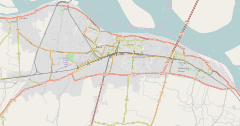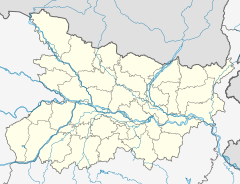
Chandragupta Maurya was the founder of the Maurya Empire, a geographically-extensive empire based in Magadha. He reigned from 320 BCE to 298 BCE. The Magadha kingdom expanded to become an empire that reached its peak under the reign of his grandson, Ashoka the Great, from 268 BCE to 231 BCE. The nature of the political formation that existed in Chandragupta's time is not certain. The Mauryan empire was a loose-knit one with large autonomous regions within its limits.
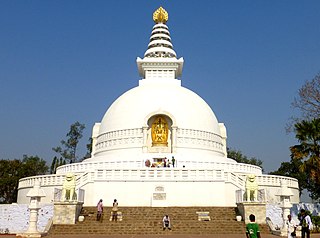
Rajgir, meaning "The City of Kings," is a historic town in the district of Nalanda in Bihar, India. As the ancient seat and capital of the Haryanka dynasty, the Pradyota dynasty, the Brihadratha dynasty and the Mauryan Empire, as well as the dwelling ground of such historical figures as The Buddha and The Mahavira, the city holds a place of prominence in Hindu, Buddhist and Jain scriptures. As of 2011, the population of the town was reported to be 41,000 while the population in the community development block was about 88,500.

The Golghar or Gol Ghar (गोलघर), is a large granary located to the west of the Gandhi Maidan in Patna, capital of Bihar state, India.

Patna, the capital of Bihar state, India, is one of the oldest continuously inhabited places in the world and the history of Patna spans at least three millennia. Patna has the distinction of being associated with the two most ancient religions of the world, namely, Buddhism and Jainism. The ancient city of Pataliputra was the capital of the Mauryan, Shunga, and Gupta Empires.
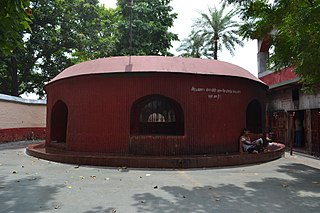
Agam Kuan is an ancient well and archaeological site in Patna, India. It is said to date back to the period of Mauryan emperor, Ashoka. It is circular in shape, lined with brick in the upper 13 metres (43 ft) and wooden rings in the remaining 19 metres (62 ft).

Patna Museum is the state museum of the Indian state of Bihar. Founded on 3 April 1917 during the British Raj to house the historical artefacts found in the vicinity of Patna, it is constructed in the style of Mughal and Rajput architecture, and is known locally as the Jadu Ghar. Artefacts from the ancient India era to 1764 have now been transferred to Bihar Museum.

The history of Bihar is one of the most varied in India.Chirand, on the northern bank of the Ganga River, in Saran district, has an archaeological record dating from the Neolithic age. Regions of Bihar—such as Magadha, Mithila and Anga—are mentioned in religious texts and epics of ancient India. Mithila is believed to be the centre of Indian power in the Later Vedic period. Mithila first gained prominence after the establishment of the ancient Videha Kingdom. The kings of the Videha were called Janakas. A daughter of one of the Janaks of Mithila, Sita, is mentioned as consort of Lord Rama in the Hindu epic Ramayana. The kingdom later became incorporated into the Vajjika League which had its capital in the city of Vaishali, which is also in Mithila.

Pataliputra, adjacent to modern-day Patna, was a city in ancient India, originally built by Magadha ruler Ajatashatru in 490 BCE, as a small fort near the Ganges river. Udayin laid the foundation of the city of Pataliputra at the confluence of two rivers, the Son and the Ganges. He shifted his capital from Rajgriha to Pataliputra due to the latter's central location in the empire.

Vaishali, Vesali or Vaiśālī was a city in present-day Bihar, India, and is now an archaeological site. It is a part of the Tirhut Division.
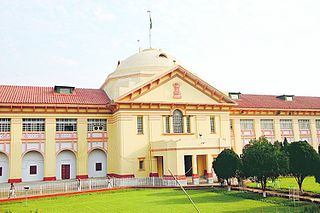
Patna, historically known as Pataliputra, is the capital and largest city of the state of Bihar in India. According to the United Nations, as of 2018, Patna had a population of 2.35 million, making it the 19th largest city in India. Covering 250 square kilometres (97 sq mi) and over 2.5 million people, its urban agglomeration is the 18th largest in India. Patna also serves as the seat of Patna High Court. The Buddhist, Hindu and Jain pilgrimage centres of Vaishali, Rajgir, Nalanda, Bodh Gaya and Pawapuri are nearby and Patna City is a sacred city for Sikhs as the tenth Sikh Guru, Guru Gobind Singh was born here. The modern city of Patna is mainly on the southern bank of the river Ganges. The city also straddles the rivers Sone, Gandak and Punpun. The city is approximately 35 kilometres (22 mi) in length and 16 to 18 kilometres wide.

Patna Medical College and Hospital was established in 1925 and originally known as Prince of Wales Medical College, is a medical college located in Patna, the state capital of Bihar, India.

The state of Bihar in eastern India, is one of the oldest inhabited places in the world with a history going back 3000 years. The rich culture and heritage of Bihar is evident from the innumerable ancient monuments that are dotted all over the state. Bihar is home to many tourist attractions and is visited by large numbers of tourists from all over the world. Around total 6 million tourists visit Bihar every year.
Bihar is a state located in the eastern part of India.

Kankarbagh, or Kankarbagh Colony, is a neighborhood and residential area in Patna, Bihar, India. It is one of the largest colonies of Asia, and second largest in terms of population.
Jp Ganga Path or Patna Marine Drive is an expressway along the Ganga river in Patna, Bihar, India. It is being jointly constructed by the Housing and Urban Development Corporation (HUDCO) and the Government of Bihar. Jp Ganga Path was planned to ensure a smooth flow of traffic between east Patna and west Patna, and ease the traffic congestion at Ashok Rajpath.
The Samrat Ashok Convention Centre is a convention centre on North Gandhi Maidan Marg, Patna, Bihar with an estimated budget of ₹490 crore. The foundation stone of the centre was laid by Nitish Kumar, the chief minister of Bihar on 8 February 2014. An expected, around 16,500 metric tonnes of steel is used in construction, which is more than the volume of steel used in raising Eiffel Tower and Indira Gandhi International Airport, New Delhi. The capacity of the main auditorium is around 5000. The Samrat Ashoka Convention centre has three major signature buildings- 1) Bapu Sabahagaar, an auditorium of 5000 seating capacity, 2) Gyan Bhawan with 800 capacity auditorium, multipurpose hall and other conference halls of various capacities; and 3) Sabhyata Dwar. The centre was completed by April 2017 and has Gyan Bhawan, Bapu Sabhagaar, Multipurpose Hall, Plenary Hall, Modular Meeting Rooms with Basement Parking, Sabhyta Park With Sabhyata Dwar & food plaza. In February 2018, Samrat Ashoka Convention Kendra Patna won the 10th CIDC Vishwakarma Achievement Award for best construction projects in India.
The culture of Magadh is rich with its distinct language, folk songs and festivals. In ancient period it was known as Magadha mahajanpada. The present-day Magadh region split between the states of Bihar and Jharkhand, India. The major language of the region is Magahi.

